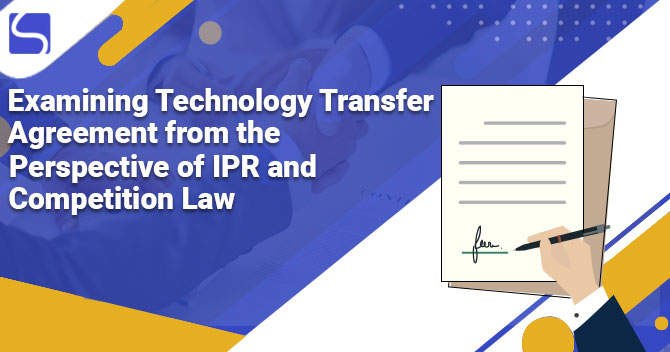Examining Technology Transfer Agreement from the Perspective of IPR and Competition Law

Karan Singh | Updated: Sep 29, 2021 | Category: Intellectual Property
The creation or inclusion of new technology has become an essential element for companies to uphold or improve their rival position in the marketplace. Companies running in sectors where the competition takes place on the basis of price only, like removal or commercialisation of raw materials, may depend on new or advanced technologies to improve their efficiency in the removal of raw materials by improving their dynamic processes or getting new machinery & equipment. While investing in technology advancement may be expensive and uncertain, there are many uncertainties associated with the innovation process. It has the benefit of preventing technological reliance on other companies or entities and enables the company to increase its technological capability and to innovate as per its own specific requirements. The developing and least developed nations, due to the lack of resources to create and the accessibility of an enormous pool of foreign technology for exploration & exploitation, attain such technology from the developed ones, giving rise to the idea of technology diffusion and technology transfer. Scroll down to check more information regarding Technology Transfer Agreement.
Table of Contents
What is the Meaning of Technology Transfer?
It is the most vital part of international business. It may occur between companies, industries, countries or even between research laboratories & their customers and involves the specific transfer or processes, products, or people. The technology transfer can be accomplished via contractual agreements between the technology source and the transfer recipient for the transfer of:

- Intangible Knowledge: In the form of techniques, experiences, skills, knowledge, and expertise via technology help, know-how.
For example: Company A agrees to transfer its (#) know-how to Company B.
- Tangible Knowledge: Information said in physical objects and codified in plans, blueprints, technical artists comprising licensing and management arrangements, purchase of machinery equipment, technological assistance agreements and assembling apparatus.
For example: Company X agrees to transfer (#) machinery to Company Y.
What is a Technology Transfer Agreement?
A Technology Transfer Agreement sets out the terms & conditions for the technology transfer in writing and creates authorised binding rights & obligations of the parties. As with the other types of contracting & sales agreements, a Technology Transfer Agreement mainly includes:
- Parties’ approval;
- Technology exchange or technical information;
- Predetermined financial thought.
Basically, a licensor or supplier assigns/licenses registered IPRs (Intellectual Property Rights) and industrial, technical support and know-how to a licensee under a Technology Transfer Agreement. The Licensee can then manufacture & distribute the products in a determined territory using the licensed technology.
A Technology Transfer Agreement (TTA) can be for domestic transactions in case the Licensee & Licensor are based in the same country. When both the parties are in different nations, the ITTA (International Technology Transfer Agreement) can be used.
Negotiation of Technology Transfer Agreements (TTAs)
The TTAs negotiation involves various legal processes & laws that regulate the transfer of technology and hence is deemed to be an enormously complex process. While negotiating a Technology Transfer Agreement, both parties should be aware that each party has its relevant interest that they will bring to the table. A victorious negotiation depends on knowing what that interest is and understanding the requirements & aspirations of both parties.
What are the Important Clauses under the Technology Transfer Agreement?
Following are some important clauses that can be seen in a Technology Transfer Agreement:
Sample Clause:
- Technology: An organisation’s plan, objectives, capabilities, and resources can utter the extent of a technology transfer. An agreement should define how and to what extent knowledge will be transferred. Furthermore, there should be a clear description of what is not included in the license. Provisions like this must be drafted carefully and correctly, without uncertainties or ambiguities. Usually, the technology transfer may comprise:
- Technology Knowledge;
- Know-how;
- Goods or Hardware;
- Field of use limitation.
Sample Clause:
This technology is developed or advanced and invented by Licensor in the course of the execution of a research project (*). Licensor owns all title, rights, and interest in the Technology and IPRs vested therein.
- Grant of License: This clause defines the scope & extent of the Licensee’s rights and any limitations on those rights. Correct & clear grant language permits the Licensee to know what he or she is empowered to do.
Sample Clause:
Licensor hereby grants to Licensee a non-transferable, royalty-free, non-exclusive right to use, sell, and manufacture the licensed products under the licensed Patents for R&D in the area.
- Warranties and Representations: This clause tells that the technology carried out is free of all security interests, liens, and other encumbrances, and the Licensor is the actual owner of the licensed technology under the contract’s provision. A classic licensor’s depiction will be that all technical details provided by the Licensor under the agreement clauses are correct and complete; and that the Licensor has the power & authority to deliver, perform, execute the agreement terms and that all licensed Patents and applications for Patent Registration under which rights have been granted.
Sample Clause: This agreement shall be regulated by the laws of (*) and shall be subject to the jurisdiction of the courts at (*).
- Indemnification: If the Licensor is not sufficiently compensated, the Licensee will involve in inappropriate or illegal uses of Intellectual Property, resulting in legal actions. If the Intellectual Property[1] or IP is not properly safeguarded or for some reason 3rd parties alleged violation, the Licensor will have to indemnify the other party.
Sample Clause: All notices provided in this agreement should be in written and shall be considered to have been duly provided when delivered by:
- Hand;
- Facsimile Transmission;
- Consistent overnight delivery service.
Competition Law, IPR and Transfer of Technology
Intellectual Property Rights like Trademark Registration, Patent Registration Copyright Registration, etc., protect the mind’s creations and ensure that the creators earn benefits from their creations. Competition Law can be determined as the set of laws that governs market competition. These laws make sure that both the clients and procedures have access to an ethical market that encourages real competition.
Any Technology Transfer Agreement that infringes a customer right by imposing difficult conditions or such conditions other than vital to safeguard the Intellectual Property Right is considered anti-competitive.
Following are some examples of Technology Transfer Agreements that may be called anti-competitive:
- Tie in arrangements to attach a product with another product that is patented so that the acquirer has to obtain the other product also from the Patent owner;
- Patent pooling wherein two or more entities come together and cross-license the technology pertaining specific technology to each other so as to limit others to get it;
- Prohibiting licensees from using technology from opponent companies;
- Price fixation for the Licensee to sell the licensed product etc. These types of clauses enforced in the TTAs by the IPR owner or Licensee are called anti-competitive for the market; hence they shall be cancelled.
Conclusion
It is concluded that IPR is an exclusive right or a reward that the State grants to the inventor to use the right commercially for a limited time, whereas the Competition Law is a legislation that is seen as an inflexible constrain over the market. Hence, although these laws appear to be contrary in nature, it turns out that they are, in fact, balancing & support each other up when one is abused.
Over the last few years, changes in the legislation have resulted in 2 laws that have a common objective but have different ways to accomplish it. It all melts down to the fact that the strong position of Intellectual Property Rights doesn’t infringe the Competition Laws but how that position is abused does.
Read our article:Various Issues Relating to the IPR in Biotechnology – An Overview














